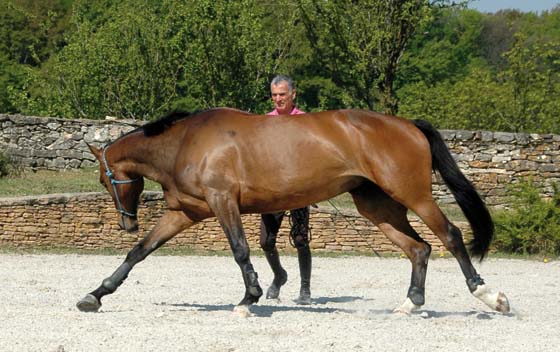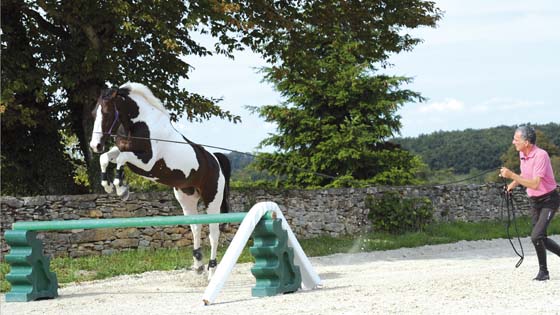I have spent hours watching horses going round on the lunge. This has allowed me to learn a great deal not only about the way they move, but also about their reactions. Horses in fact do exactly the same, whether on the lunge or free, they study human beings’ reactions. After going round a few times, a subtle dominating/dominated game begins, rather like with dog. Sometimes the horse needs dominating, without exaggeration of course, or you will restrict its movements, sometimes it will dominate, freely showing its joy and pleasure to be able to move freely.
I remember Jean-Claude, a groom I employed a few years ago. The day he arrived in the yard, I asked him to lunge one of my horses. After going round for a few times and after a few happy bucks, the horse stopped and waited, looking at the man at the other end of the lunge. A slightly surprised Jean-Claude cracked his whip, but after a while the horse stopped again and turned to face him.
Watching this scene, I asked Jean-Claude:
« Where do you look when lunging a horse? «
« Well, I think I look at its head! «
It is true, all those who have never learned to lunge tend to place themselves ahead of the horse, looking at its head. Now, as we know, horses are animals that flee. Their nature induces natural reflexes: forward movement comes more easily if a horse feels ‘pushed’ by a potential danger situated behind it.
But, if the danger is in front of it, the horse will tend to stop and to back off in the other direction.
When lunging, these same reflexes lead the horse to move forwards or stop.
So I asked Jean-Claude to continue lunging while looking at the horse’s hocks, at the height of the girth and then looking at its head. «Try to understand the horse’s various ways of behaving depending on the point you look at.»
Jean-Claude quickly learned that when using a focused view on the hindquarters, the horse feels that it should move forwards.
A little later, Jean-Claude concluded that a wide-angle view behind the girth was the most satisfactory, because it allowed him to have a calm horse with regular paces.
Whether mounted or on the lunge, the logic for using aids is identical. Like pointless leg pressure, the horse will quickly become indifferent to clucking or incessant cracks of the whip. You must decide on the gait or the speed and then stop all requests when receiving the correct answers. We have analysed this in the Chapter “Rider/Horse Communication”.
Pay attention to your hands, your position, your voice, your movements … Whether in the saddle or on foot, you must control your attitude: the back upright, eyes looking into the distance, shoulders relaxed, and the legs supple…
The tiniest rigidity in the person holding the lunge has repercussions on the horse. Try to be aware of this and place each part of your body in the right position. It is only when all these conditions have been achieved, that your horse will be free to allow its muscles and joints to work in the correct attitude.
Your breathing must also be regular, allowing the horse to be in confidence. And above all use your voice: «Whoa! Whoa!» to slow it down and calm it, followed by silence. The tone is important, and often better understood than the meaning of the words themselves.
This reminds me of a little anecdote told by my brother, Jacques Robert, while he was teaching a group of young riders and horses he knew very well. He gave the order to turn across the school and halt along the centreline. Of course, everyone obeyed and lined up facing him. Jacques then asked the riders to trot along the side of the school with their hands in their backs, then in exactly the same tone of voice as before he ordered: «you are all imbeciles!»
All the horses turned across the school and halted in front of him. The riders were speechless. This little story well illustrates to what extent horses are sensitive to the tone of the voice rather than to the meaning of words. Intonation is very easy to use both for rewarding the horse and for imposing one’s will.
Extract of the book "Secrets and method of a great champion"
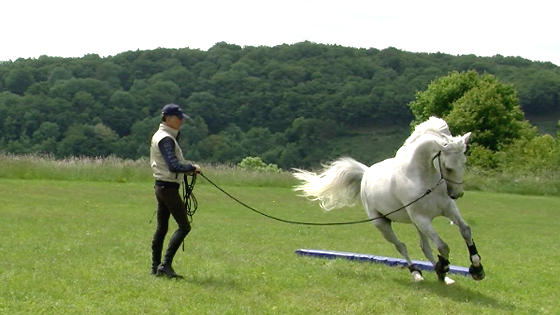

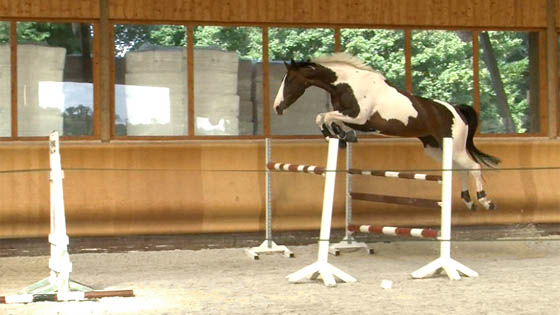
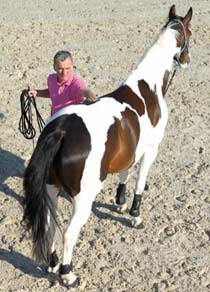 The sport horse’s back is the most engaged area of his body and the most fragile, We have to pay a particular attention to the area from the withers to the base of the tail. Most pathology, including lameness, takes root in the malfunction of the top line. It’s pretty obvious that a horse with back pain will not be able to perform any athletic activity.
The sport horse’s back is the most engaged area of his body and the most fragile, We have to pay a particular attention to the area from the withers to the base of the tail. Most pathology, including lameness, takes root in the malfunction of the top line. It’s pretty obvious that a horse with back pain will not be able to perform any athletic activity.